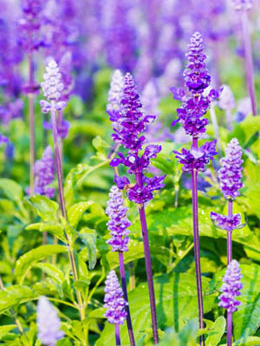Salvia plants are some of the most preferred garden plants, valued for their culinary, medicinal, and aesthetic uses. You can grow and maintain healthy salvias with little effort in your garden. This Buzzle article tells you how to grow salvia plants.

Salvia plants are popular landscaping species that share the same family
Lamiaceae with mint and sage herb. The genus
Salvia comprises more than 900 species, making it the largest genus in the mint family. Consequently, the species of salvia are variant in their growth habit; while some are woody and bushy shrubs, others are annual, biennial, or perennial herbs. Perennial salvia varieties are opted for their midsummer flowering.
As we all know, sage (
Salvia officinalis) is a flavorful culinary herb used for seasoning meat items. Speaking about salvia effects, the extract of Salvia divinorum is found to be the most potent hallucinogen of all the other plant sources. Likewise, the diversity of salvia plants is so vast that some are used for culinary and medicinal purposes; whereas other species are planted as ornamental plants, especially for their showy flowers.
Characteristics
- Over 500 salvia species are native to South America and Mexico.
- Commonly known as sage, the stem is angular, bearing aromatic foliage with smooth or toothed margin.
- Some species bear tiny, hair-like trichomes in the stems and leaves, which help in reducing water loss.
- Based on the cultivar, the inflorescence type may be panicle, raceme, or a long and dense spike.
- As far as flower color is concerned, it is available in shades of white, yellow, pink, red, and blue.
- They are heat and drought tolerant, and thrive in US hardiness zones 3 through 9.
- They are excellent for growing as ground covers or in garden beds and borders.
- They grow up to 3 feet in height and about 1 foot in width.
- When blooming in groups, they are eye-catchers in any garden layout, and are low maintenance. What's more? They attract bees, butterflies, and hummingbirds in the garden.
Growing Salvia PlantsBeing tolerant to drought conditions, salvias are very easy to grow. The most concerning part is selecting the right species suitable for the climatic conditions in your area. Also, according to your approach (therapeutic, culinary, or aesthetic) of planting them, choose the correct cultivars. Following are some gardening tips for planting salvia in your flower garden:
- The best way to propagate ornamental salvia plants is by seeds. They are cheap, easy to germinate, and transplant in garden soil. You can also grow these plants from cuttings and clippings.
- Salvia plants perform best in full sunlight. If such areas are not available in your flower garden, prepare soil in partial shaded location. Or a more simple option is to grow salvia plants in pots or containers.
- The soil should be prepared in such a way that it is moist, well-drained, and rich in nutrients. Waterlogged soil and excess humidity are strictly not recommended for maintaining healthy plants.
- You can plant salvia in spring time. Before plantation, add a heavy dose of farmyard compost and loosen the soil up to a depth of about 12―15 inches. Make a planting hole larger than the root ball and place the plant without damaging the root system.
- Fill the hole with garden soil and gently press the soil around the main stem.
- Similarly, plant the remaining salvia plantlets, leaving a space of about 2―3 feet between two plants. Water the salvia plants thoroughly after planting.
- Laying a mulch layer and supplementing the soil with organic compost in spring is super helpful. For best results, water them to about 1-inch per week.
- If required, prune the stems to promote development of new flower buds.
Grow salvia plants and fill your garden with the heady fragrance of salvia leaves. You will also get to enjoy the beautiful flowers for a longer period. Salvia blooms are also excellent for using as cut flowers.






 Salvia plants are popular landscaping species that share the same family Lamiaceae with mint and sage herb. The genus Salvia comprises more than 900 species, making it the largest genus in the mint family. Consequently, the species of salvia are variant in their growth habit; while some are woody and bushy shrubs, others are annual, biennial, or perennial herbs. Perennial salvia varieties are opted for their midsummer flowering.
Salvia plants are popular landscaping species that share the same family Lamiaceae with mint and sage herb. The genus Salvia comprises more than 900 species, making it the largest genus in the mint family. Consequently, the species of salvia are variant in their growth habit; while some are woody and bushy shrubs, others are annual, biennial, or perennial herbs. Perennial salvia varieties are opted for their midsummer flowering.